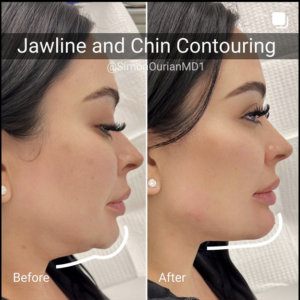Let us explore the art and science of reshaping the chin to achieve balance and enhance one’s beauty. This guide will equip you with the knowledge and insights necessary to make well-informed decisions about chin augmentation.
What is chin augmentation?
Chin augmentation is a technique that involves altering or enhancing the size and appearance of the chin through non-surgical means such as chin implants and fillers or bone surgery. The primary objective is to improve balance and aesthetics.
What are the treatments or methods for chin augmentation?
There are non-surgical techniques available for performing chin augmentation. The choice of technique depends on factors such as the patient’s goals, facial structure, and recommendations from the surgeon. Here is an overview of some methods:
1. Chin Implants (Surgical Method) – An incision is made inside the mouth, beneath the chin, or submental. The surgeon creates a pocket above the chin bone and inserts an implant typically made of silicone or other materials compatible with the body. The size and shape of the implant are carefully chosen to achieve the desired chin projection and improve aesthetics. Once the implant is in place, the incision is closed, then the patient is closely monitored during their recovery.
2. Another surgical method called sliding genioplasty involves making incisions inside the mouth. The surgeon then cuts the chin bone then repositions it to achieve the desired outcome; in some cases, screws or plates may be used to secure the bone in its position. Once the desired chin projection has been achieved, the incisions are closed.
3. Non-surgical chin augmentation can be done using fillers such as acid or collagen injections targeted at specific areas of the chin. These fillers are strategically placed to enhance both projection and contour without requiring any incisions. It is important to note that this procedure provides results and may require touch ups.
4. Fat grafting is another surgical method for chin augmentation where fat cells from other parts of your body are injected into your chin area for added volume and contouring purposes. This procedure involves extracting fat from another part of the patient’s body using liposuction; the extracted fat is then injected into the chin to enhance its appearance.
The choice of method depends on the patient’s goals, existing chin structure, preferences as the surgeon’s expertise. It is important to consult with a qualified aesthetic provider to determine the suitable approach and discuss potential risks, benefits, and recovery process associated with chin augmentation.
Is chin augmentation painful?
Chin augmentation can cause some discomfort, but it can generally be managed with pain medications and typically improves as the healing process progresses.
Is chin augmentation safe?
Chin augmentation is generally considered safe when performed by an experienced medical professional at Epione. However, all surgical procedures carry some risks, and It is crucial to choose a qualified aesthetic provider and have in-depth discussions about risks and benefits before making a decision.
How long does it take to recover from chin augmentation?
The recovery time for chin augmentation can vary depending on factors such as the method used, healing processes, and the extent of the procedure. Here is a general timeline for the recovery process after chin augmentation:
1. Surgical Chin Augmentation (Implants or Genioplasty):
During the 7-10 days, you can expect swelling and bruising. Most patients are able to return to work and regular activities within 1-2 weeks. It may take weeks to a month for full recovery, including the complete resolution of swelling and bruising.
2. Non-surgical chin augmentation (Fillers or Fat Grafting):
Swelling and discomfort are typically minimal after the procedure and usually resolve within a day. Also, you can usually resume your activities afterward.
It is important to follow your surgeon’s operative care instructions for a smooth recovery. While you may feel ready to get to normal, it takes time for your body to fully heal and achieve optimal results. Be patient during this process, and do not hesitate to consult with your surgeon if you have any concerns.
